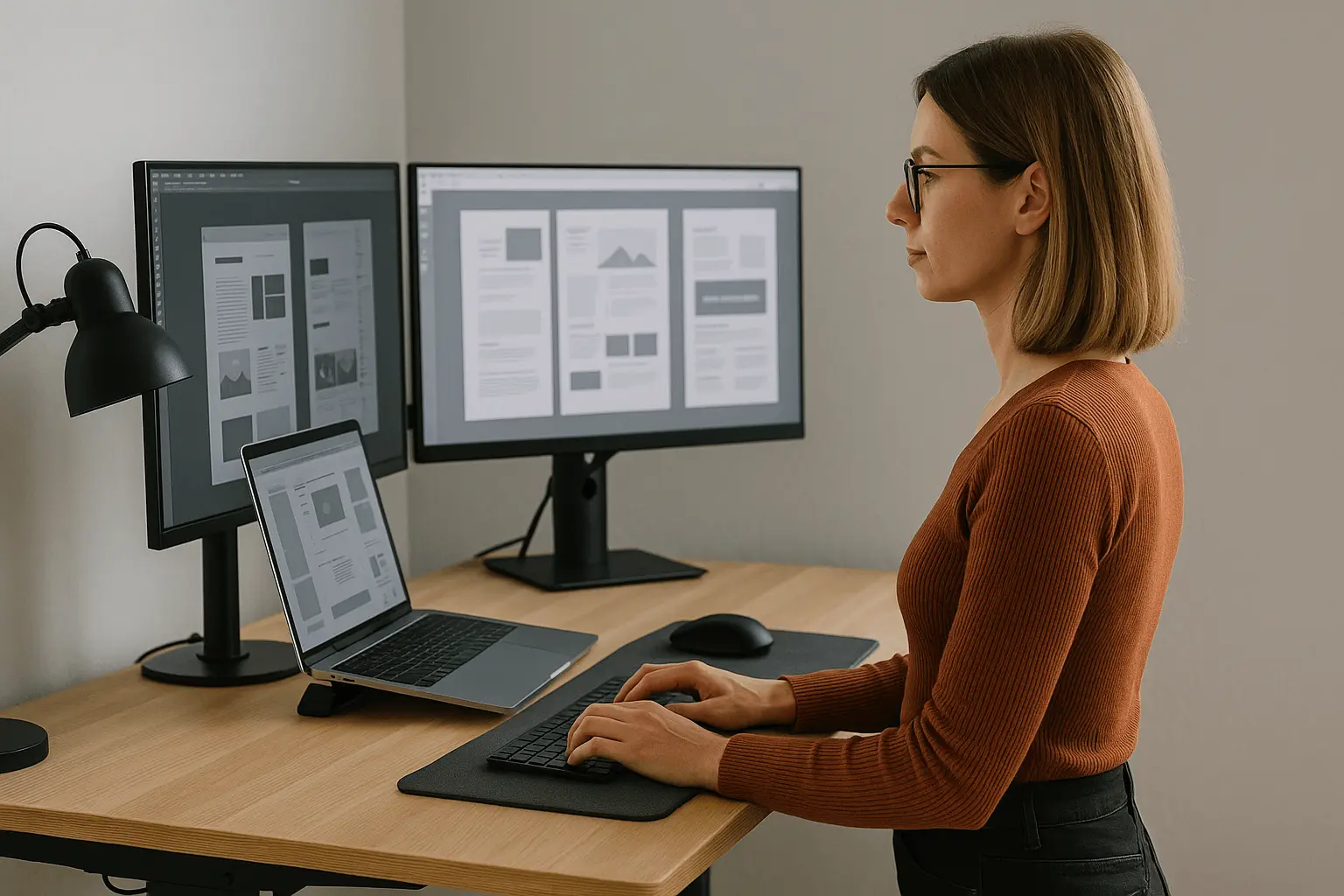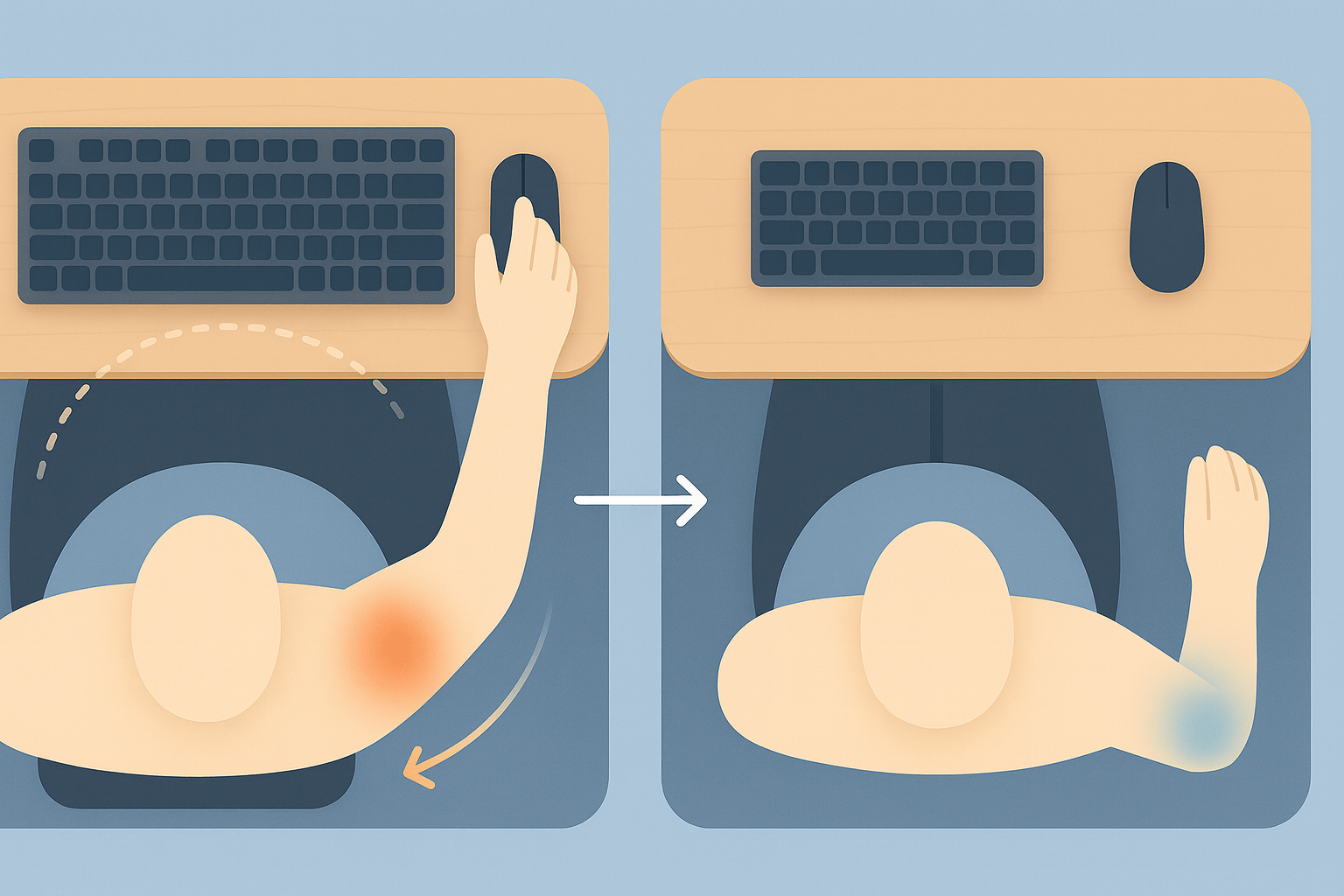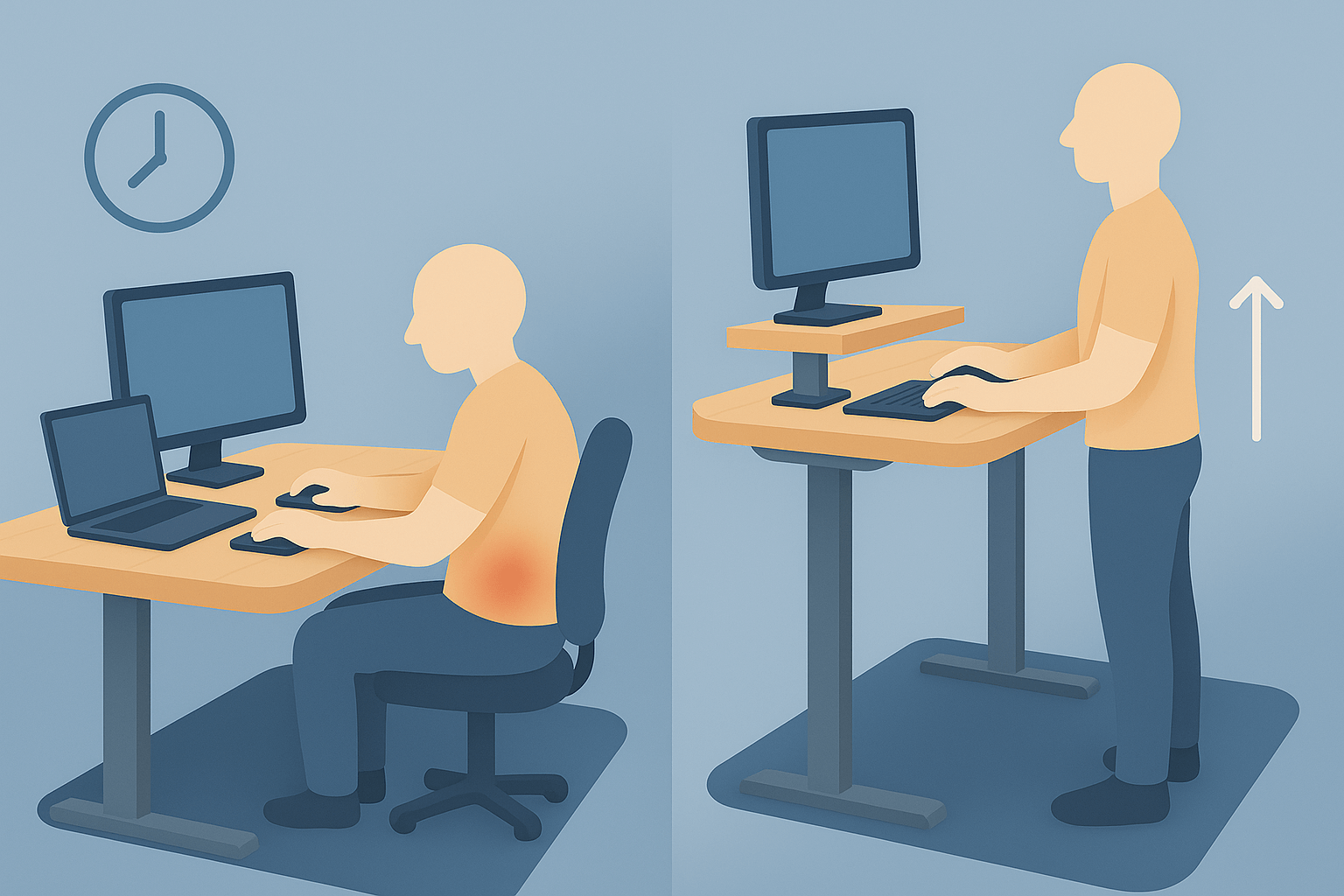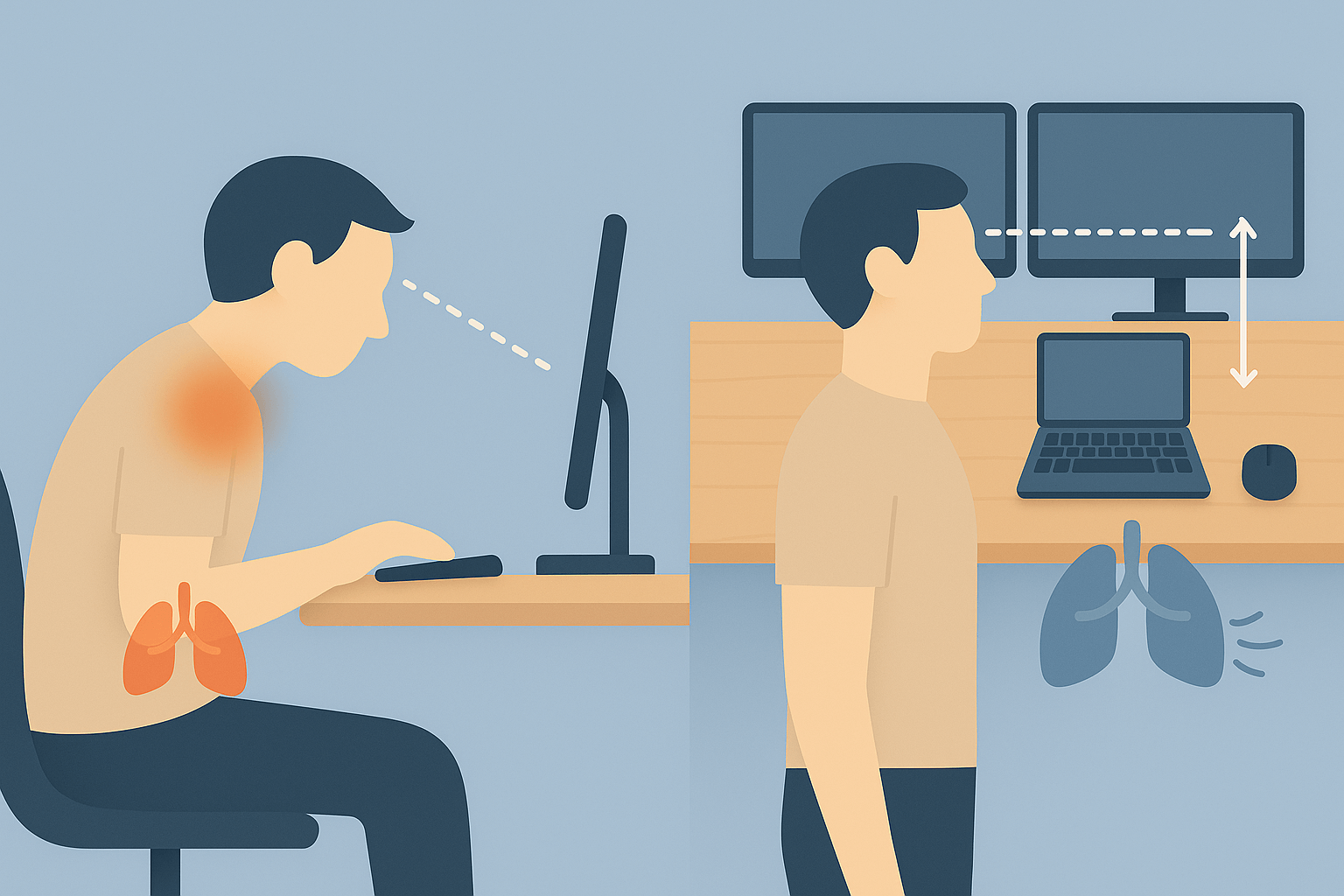The ergonomic transformation that changed my workday forever
Posted by Nuno Marques on 3 Oct 2025

The ergonomic transformation that changed my workday forever
The pain was undeniable. Every evening as I shut down my computer after a full day of UI/UX engineering work, my right shoulder screamed in protest and my neck felt locked in a vice. I'd massage the knots, stretch it out, and hope tomorrow would be different. But for months, tomorrow was always the same.
What I didn't realize was that my "normal" desk setup was slowly breaking down my body — and that three simple changes would transform not just my physical comfort, but my entire relationship with work.
This is the story of how I went from daily pain to daily energy, from dreading the afternoon slump to maintaining focus until 6 PM, from ending each workday exhausted to having genuine enthusiasm for evening activities.
The hidden cost of "normal" desk work
When I started my career in UI/UX engineering, I set up my workstation like everyone else: standard desk, office chair, full-size keyboard with numpad, mouse to the right. It looked professional. It felt normal. And it was quietly destroying my body.
The immediate impact was clear: office workers commonly experience neck pain and stiff necks from prolonged sitting.1 I was firmly in that majority, and the culprit wasn't just sitting — it was how I was sitting and what equipment I was using.

Discovery one: the keyboard that was sabotaging my posture
My first breakthrough came from an unexpected conversation with a physical therapist friend who noticed me rubbing my right shoulder. She asked: "How far is your mouse from your body?"
I'd never thought about it. My full-size keyboard with its numpad was 45 cm (18 inches) wide, pushing my mouse far to the right. To use it, my right arm constantly reached outward, creating "shoulder abduction": my arm winging away from my body's centerline. Hour after hour, this position was overworking my shoulder muscles.
Standard keyboards with permanently attached numpads force your mouse significantly further from your body's midline, requiring continuous muscle activation in your neck and shoulders.2 When your arm is extended and unsupported, you're essentially doing a very slow, very long shoulder exercise — all day long.
I switched to a compact keyboard without the numpad. The change was immediate. By removing just 10 centimeters of keyboard width, I could position my mouse within my natural reach zone. My right arm could rest near my centerline instead of constantly reaching. Within two weeks, that screaming shoulder pain had diminished by 70%.
Studies show that ergonomic workstation adjustments, including keyboard positioning that supports your arms on the desk, significantly reduce shoulder pain by decreasing muscle activity in problem areas.3

Discovery two: standing desks as a game changer
Two years into my improved setup, I got a standing desk. I'll be honest: I was skeptical. Standing all day sounded exhausting. But chronic lower back stiffness was starting to replace my shoulder issues.
The transformation wasn't instant — it was strategic. Standing desks don't work simply because standing is better than sitting. They work because they enable movement variability. Research shows the optimal approach is alternating between sitting and standing, with around 30 minutes of standing per hour as a minimum.4
I developed my routine through experimentation: I alternate one hour seated with one hour standing. Each time I raise my desk, my body reactivates. Muscles that were compressed while sitting now engage, blood flow increases, and my energy lifts.
After three years of consistent sit-stand alternation, I've experienced what research participants report: near-complete elimination of back pain, sustained energy throughout the workday, better mood, and, most importantly, genuine energy for activities after work.5 I don't collapse on the couch at 6:30 PM anymore.

Discovery three: monitor height and breathing capacity
The final piece addressed something I never connected to my desk setup: that subtle feeling of breathlessness and mental fog during afternoon work sessions.
Poor posture literally restricts your breathing. When your head tilts forward to look at a monitor positioned too low, your neck muscles go into constant contraction, your body fatigues, and your breathing becomes shallow.
I adjusted my monitors based on ergonomics research: monitor tops at or slightly below eye level, positioned at arm's length distance. My MacBook Pro sits on a stand with two external monitors flanking it, all at identical heights. No more looking down. No more neck strain.
The cognitive difference was remarkable. Research found that sitting upright increases positive thinking and improves task performance, while slouching worsens mood.6 My afternoon mental clarity improved dramatically within days.
Your action plan: replicating the transformation
You don't need to overhaul everything simultaneously. Start with the highest-impact changes:
Week 1: Fix your keyboard and mouse
If you use a full-size keyboard with numpad, get a compact keyboard (tenkeyless). This single change brings your mouse 10 centimeters closer to your body, dramatically reducing shoulder strain.
Position your keyboard so your forearms rest on the desk surface. Your elbows should form a 90-120 degree angle with your arms hanging naturally at your sides.
Week 2: Optimize your monitor
Adjust your monitor so the top of the screen sits at or slightly below eye level, at arm's length distance: 50-75 cm (20-28 inches) from your face.
Laptop users: get a laptop stand and external keyboard immediately. Working hunched over a laptop creates the perfect storm of poor ergonomics.
Week 3-4: Introduce movement
If you have a standing desk, start gradually: 20-30 minutes of standing every two hours in week one. Increase to 30 minutes per hour by week two. Your body needs time to adapt.
If you don't have a standing desk, stand during phone calls, while reading, or during video meetings. Set a timer for every 30 minutes to change positions or take a brief walk.
Get an anti-fatigue mat if you stand regularly, as it reduces leg fatigue by encouraging micro-movements that improve circulation.
What three years taught me
Looking back at the UI/UX engineer who dragged himself through workdays with screaming shoulder pain, I barely recognize that person. Not because the work changed — I still spend 8+ hours daily at my computer — but because my body's relationship with that work transformed completely.
The keyboard change gave me pain relief. My shoulder stopped screaming.
The standing desk gave me energy. That 3 PM slump where I'd zone out? Gone. The evening exhaustion? Replaced with genuine enthusiasm for activities, workouts, time with friends, and the energy to work on side projects and continue learning after hours.
The monitor adjustment gave me mental clarity. The subtle afternoon brain fog lifted, and my focus sustained through full workdays.
But the most unexpected benefit was psychological. When you feel physically good at work — when your body isn't fighting your setup every moment — work itself becomes more enjoyable. The same projects, the same deadlines, the same challenges... but experienced through a body that's supported rather than strained.
The invitation to transform
You don't have to accept pain as the price of your job. You don't have to end every workday exhausted, and you don't have to sacrifice your evenings to recover from workdays that drained you.
The transformation I experienced is replicable. The science is clear, the interventions are straightforward, and the benefits are profound. Whether you start with a compact keyboard, adjust your monitor height, or begin alternating sitting and standing, you're taking control of your wellbeing.
Three years ago, I thought shoulder pain was just part of software development work. I thought afternoon exhaustion was normal.
I was wrong, and that's the best news possible! Because if these problems aren't inevitable, they're solvable. And solving them doesn't just change your workday, but it changes everything that comes after.
Your ergonomic transformation starts with a single adjustment. Make it today.
Footnotes
-
Canadian Centre for Occupational Health and Safety. (n.d.). Working in a Sitting Position - Overview. https://www.ccohs.ca/oshanswers/ergonomics/sitting/sitting_overview.html ↩
-
Canadian Centre for Occupational Health and Safety. (n.d.). Office Ergonomics - Keyboard Selection and Use. https://www.ccohs.ca/oshanswers/ergonomics/office/keyboard.html ↩
-
Rodrigues, M. S., et al. (2021). Effect of an ergonomic intervention involving workstation adjustments on musculoskeletal pain in office workers. BMC Public Health, 21, 645. https://www.ncbi.nlm.nih.gov/pmc/articles/PMC8010160/ ↩
-
Callaghan, J. P., et al. (2015). How long should you stand rather than sit at your work station? University of Waterloo News. https://uwaterloo.ca/news/how-long-should-you-stand-rather-sit-your-work-station ↩
-
Pronk, N. P., et al. (2012). Reducing Occupational Sitting Time and Improving Worker Health: The Take-a-Stand Project, 2011. Preventing Chronic Disease, 9, E154. https://www.cdc.gov/pcd/issues/2012/11_0323.htm ↩
-
Nair, S., et al. (2015). Do slumped and upright postures affect stress responses? A randomized trial. Health Psychology, 34(6), 632-641. ↩